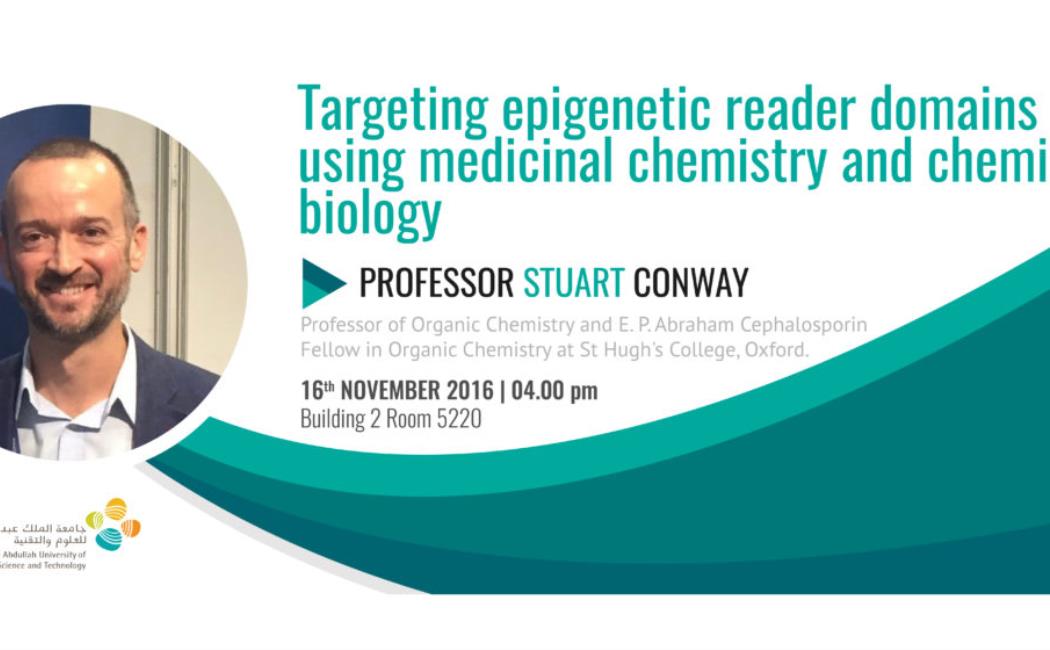
Targeting epigenetic reader domains using medicinal chemistry and chemical biology
Epigenetics, defined as “stably heritable phenotype resulting in changes in a chromosome without alterations in the DNA sequence”,1 comprises regulatory mechanisms of chromatin state that control access to DNA, mediated by noncoding RNA, DNA methylation, nucleosome remodeling histone variants, and some histone post-translational modifications (PTMs).2 Histone PTMs are dynamic, with cellular machinery identified that can add these modifications and that can remove them.3 The third class of proteins, termed “readers”, has been identified, that binds to PTMs and thus stabilize large protein assemblies, which are often involved in transcriptional regulation. Bromodomains, protein modules that act as readers of lysine acetylation state, have emerged as important therapeutic targets for a number indication, especially in oncology.4-6 We have developed small molecule inhibitors of the bromodomain and extra terminal domain (BET) family of bromodomain-containing proteins,7,8 and the CREB-binding protein (CREBBP) bromodomain.9,10 Recent developments in the optimization of these probes will be discussed, with a view to the development of small molecule ligands for other non-BET bromodomains. The application of these probes to study the chemical biology of epigenetic reader proteins will be discussed.11
- Berger, S. L.; Kouzarides, T.; Shiekhattar, R.; Shilatifard, A. An Operational Definition of Epigenetics. Genes Dev. 2009, 23, 781-783.
- Conway, S. J.; Woster, P. M.; Shen, J.-K.; Georg, G.; Wang, S. Epigenetics: Novel Therapeutics Targeting Epigenetics. J. Med. Chem. 2015, 58, 523-524.
- Arrowsmith, C. H.; Bountra, C.; Fish, P. V.; Lee, K.; Schapira, M. Epigenetic Protein Families: a New Frontier for Drug Discovery. Nat. Rev. Drug Disc. 2012, 11, 384-400.
- Hewings, D. S.; Rooney, T. P. C.; Jennings, L. E.; Hay, D. A.; Schofield, C. J.; Brennan, P. E.; Knapp, S.; Conway, S. J. Progress in the Development and Application of Small Molecule Inhibitors of Bromodomain-Acetyl-Lysine Interactions. J. Med. Chem. 2012, 55, 9393-9413.
- Jennings, L. E.; Measures, A. R.; Wilson, B. G.; Conway, S. J. Phenotypic Screening and Fragment-Based Approaches to the Discovery of Small-Molecule Bromodomain Ligands. Future Med. Chem. 2014, 6, 179-204.
- Brand, M.; Measures, A. M.; Wilson, B. G.; Cortopassi, W. A.; Alexander, R.; Höss, M.; Hewings, D. S.; Rooney, T. P. C.; Paton, R. S.; Conway, S. J. Small Molecule Inhibitors of Bromodomain-Acetyl-Lysine Interactions. ACS Chem. Biol. 2015, 10, 22-39.
- Hewings, D. S.; Wang, M.; Philpott, M.; Fedorov, O.; Uttarkar, S.; Filippakopoulos, P.; Picaud, S.; Vuppusetty, C.; Marsden, B.; Knapp, S.; Conway, S. J.; Heightman, T. D. 3,5-Dimethylisoxazoles Act as Acetyl-Lysine-Mimetic Bromodomain Ligands. J. Med. Chem. 2011, 54, 6761-6770.
- Hewings, D. S.; Fedorov, O.; Filippakopoulos, P.; Martin, S.; Picaud, S.; Tumber, A.; Wells, C.; Olcina, M. M.; Freeman, K.; Gill, A.; Ritchie, A. J.; Sheppard, D. W.; Russell, A. J.; Hammond, E. M.; Knapp, S.; Brennan, P. E.; Conway, S. J. Optimization of 3,5-Dimethylisoxazole Derivatives as Potent Bromodomain Ligands. J. Med. Chem. 2013, 56, 3217-3227.
- Rooney, T. P. C.; Filippakopoulos, P.; Fedorov, O.; Picaud, S.; Cortopassi, W. A.; Hay, D. A.; Martin, S.; Tumber, A.; Rogers, C. M.; Philpott, M.; Wang, M.; Thompson, A. L.; Heightman, T. D.; Pryde, D. C.; Cook, A.; Paton, R. S.; Muller, S.; Knapp, S.; Brennan, P. E.; Conway, S. J. A Series of Potent CREBBP Bromodomain Ligands Reveals an Induced-Fit Pocket Stabilized by a Cation-π Interaction. Angew. Chem. Int. Ed. 2014, 53, 6126-6130.
- Hay, D. A.; Fedorov, O.; Martin, S.; Singleton, D. C.; Tallant, C.; Wells, C.; Picaud, S.; Philpott, M.; Monteiro, O. P.; Rogers, C. M.; Conway, S. J.; Rooney, T. P. C.; Tumber, A.; Yapp, C.; Filippakopoulos, P.; Bunnage, M. E.; Muller, S.; Knapp, S.; Schofield, C. J.; Brennan, P. E. Discovery and Optimization of Small-Molecule Ligands for the CBP/P300 Bromodomains. J. Am. Chem. Soc. 2014, 136, 9308-9319.
- Sekirnik née Measures, A. R.; Hewings, D. S.; Theodoulou, N. H.; Jursins, L.; Lewendon, K. R.; Jennings, L. E.; Rooney, T. P. C.; Heightman, T. D.; Conway, S. J. Isoxazole-Derived Amino Acids Are Bromodomain-Binding Acetyl-Lysine Mimics: Incorporation Into Histone H4 Peptides and Histone H3. Angew. Chem. Int. Ed. 2016, 55, 8353-8357.
Biosketch: Stuart Conway is a Professor of Organic Chemistry at the University of Oxford, and the E. P. Abraham Cephalosporin Fellow in Organic Chemistry at St Hugh’s College, Oxford. He studied Chemistry with Medicinal Chemistry at the University of Warwick before undertaking PhD studies with Professor David Jane in the Department of Pharmacology at the University of Bristol. Stuart completed post-doctoral studies with Professor Andrew Holmes FRS at the University of Cambridge working on the synthesis of inositol polyphosphates. In 2003, he was appointed as a Lecturer in Bioorganic Chemistry at the University of St Andrews, in 2008 was appointed as an Associate Professor at Oxford, and in October 2014 he was promoted to Full Professor. Between March and August 2013 Stuart was a Visiting Professor at the California Institute of Technology, hosted by Professor Bob Grubbs and Professor Dianne Newman. He is an Associate Editor of the Journal of Medicinal Chemistry. Stuart’s research focuses on the development of molecular tools to enable the study of biological systems. This work has been recognised by the award of the 2012 Prize for a Young Medicinal Chemist in Academia by the European Federation for Medicinal Chemistry, and the 2016 Lectureship of the Biological and Medicinal Chemistry Section of the RSC.